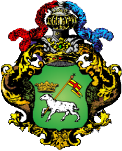|
On October 18, 1444, the first stone of the tribune was laid. Designer and director of the works was Michelozzo di Bartolommeo together with Pagno Portigiani, a project revised by Alberti. The sacristy, the Villani chapel, the chapel of the Madonna, the cloister of the Vows, the Oratory of San Sebastiano and the left part of the nave were built and restored. The works lasted until 1453 and resumed in 1460 under the direction of Antonio Manetti. Following financial problems, the friars offered the patronage of the factory to Lodovico III Gonzaga, duke of Mantua and finally, in 1477, after slight modifications to the previous project of Leon Battista Alberti, the tribune was completed. In 1481 the central nave was also finished. The church was presented with a roof supported by trusses, arches and cornices in stone. In the sixteenth century, work on the church slowed down. However the frescoes of the cloister of the vows were painted. On 17 January 1516, Cardinal Antonio del Monte, legate of Leo X, solemnly consecrated the church.
Towards the end of the 16th century, the Pucci family financed the construction of the external portico (see the coat of arms in the floor on the sides of the portico). In 1601, still under the financing of the Pucci family, the stairway was created in front of the church to link all the columns of the square at the same level and give uniformity to the whole. In 1664 Mattia de 'Medici son of Cosimo II gave his help to build the ceiling of the church. It was designed by Baldassarre Franceschini, known as Volterrano, who painted the Madonna Assunta there. The choir was clad in marble and stone and in 1680 the Volterrano began to fresco the dome, ending it three years later. Towards the end of the 16th century, the Pucci family financed the construction of the external portico (see the coat of arms in the floor on the sides of the portico). In 1601, still under the financing of the Pucci family, the stairway was created in front of the church to link all the columns of the square at the same level and give uniformity to the whole. In 1664 Mattia de 'Medici son of Cosimo II gave his help to build the ceiling of the church. It was designed by Baldassarre Franceschini, known as Volterrano, who painted the Madonna Assunta there. The choir was clad in marble and stone and in 1680 the Volterrano began to fresco the dome, ending three years later. In 1687 the friars decided to cover the lower part of the church with marble, stucco and paintings. Between 1783 and 1795 the church was again repaved and on this occasion many of the original tombstones were irretrievably lost. In 1857 a last great restoration was carried out by the architect Giuseppe Poggi. The church was reopened to the public on August 20 of the same year in the presence of Pope Pius IX who celebrated at the altar of the Madonna.
Curiosity
* On the right side of the basilica there is a small arch that connects it to the Palazzo della Crocetta, seat of the National Archaeological Museum of Florence. This passage was built so that the princess Maria Maddalena de 'Medici, sister of the Grand Duke Cosimo II, frail if not malformed, could go to Mass without going down the street: inside the church there is a golden grating, corresponding to a small compartment at the end of the arch. The corridors suspended around the building are 5 in total and connect both the Spedale degli Innocenti and the buildings beyond Via Laura and Via della Pergola.
* In 2007, in the western part of the convent, on a small staircase of the staircase built by Michelozzo, a lunette with an Annunciation attributed to Paolo Uccello was rediscovered. |





